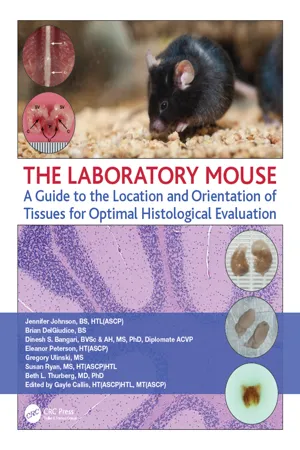
The Laboratory Mouse
A Guide to the Location and Orientation of Tissues for Optimal Histological Evaluation
- 93 pages
- English
- ePUB (mobile friendly)
- Available on iOS & Android
The Laboratory Mouse
A Guide to the Location and Orientation of Tissues for Optimal Histological Evaluation
About this book
Key features:
- High quality full color photographs and descriptive texts on the location and removal of the organs from the mouse
- Instructive methods and clear visuals for trimming and orienting the organs for paraffin histology to obtain the best possible sections for analysis
- Full color photomicrographs of the resulting section for each organ stained with hematoxylin and eosin demonstrating important features and landmarks for the histologist to ensure the optimal area for analysis is achieved
- All in one, easy to use guide organized by individual organs of the laboratory mouse
-
Spiralbound for easy reference in the lab
This "one-stop" guide offers an essential resource for any academic, research or development operation where mouse necropsy and/or histology are performed. Connecting the reader 'from the mouse to the microscope', it provides a detailed guide for locating, trimming, orientating and embedding of the most frequently investigated tissues collected in the laboratory mouse. It shows where the organs reside in the mouse, how to trim and embed them as well as the resulting optimal sections. This guide brings together the wealth of scattered information into one high-quality text, the emphasis is on providing knowledge that will help histologists and scientists get better results in any downstream assays where ideal sections are needed.
Frequently asked questions
- Essential is ideal for learners and professionals who enjoy exploring a wide range of subjects. Access the Essential Library with 800,000+ trusted titles and best-sellers across business, personal growth, and the humanities. Includes unlimited reading time and Standard Read Aloud voice.
- Complete: Perfect for advanced learners and researchers needing full, unrestricted access. Unlock 1.4M+ books across hundreds of subjects, including academic and specialized titles. The Complete Plan also includes advanced features like Premium Read Aloud and Research Assistant.
Please note we cannot support devices running on iOS 13 and Android 7 or earlier. Learn more about using the app.
Information
Table of contents
- Cover
- Half Title
- Title Page
- Copyright Page
- Table of Contents
- Preface
- Adrenal Glands
- Brain
- Brain - Trimming for Coronal Sections
- Brain - Trimming for Sagittal Sections
- Diaphragm
- Esophagus, Trachea and Thyroid
- Eyes
- Female - Ovaries, Oviducts
- Female - Uterus (Uterine Horn), Cervix, Vagina
- Femur
- Heart
- Kidneys
- Liver and Gallbladder
- Lung (Inflated)
- Lymph Nodes - Axillary
- Lymph Nodes - Mesenteric
- Male - Epididymis
- Male - Preputial Gland
- Male - Seminal Vesicle, Coagulating Gland, Prostate Gland
- Male - Testes
- Pancreas
- Pituitary Gland
- Quadriceps Muscle
- Salivary Glands
- Sciatic Nerve
- Skin with (or without) Mammary Gland
- Spinal Cord
- Spine
- Spleen
- Sternum
- Stomach - Open Method
- Stomach - Whole Method
- Stifle Joint
- Thymus
- Tongue
- Urinary Bladder
- Intestines
- Small Intestine - Duodenum
- Small Intestine - Jejunum
- Small Intestine - Ileum
- Large Intestine - Cecum
- Large Intestine - Colon
- Large Intestine - Rectum
- Materials and Methods
- References